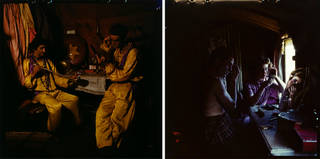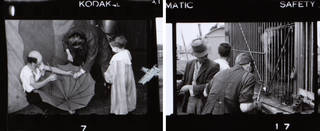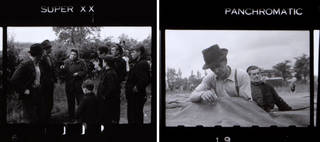Following his series of colour photographs of gardens published in Of Cabbages and Kings (1945) and his article Colour Photography Practice (1939), written for the British Journal of Photography, Hinde embarked on his next major project – to capture circus life in Britain.

Hinde's circus photography was intended to be published in the book British Circus Life (1948), written by renowned circus and Romany historian Lady Eleanor Smith (1902 – 45). It was decided that Hinde would initially spend three weeks staying with a circus to take his photographs.
Before 1939 all of the major circuses, such as Bertram Mills and Chipperfields, travelled to venues across the country by train, but under war-time conditions this was no longer possible. Hinde was able to make contact though with Reco Circus, one of the smaller, family tenting circuses that was still able to operate. He left London on 13 June 1944, the night before the first aerial bombardment of the city and arrived the following day in Kilmarnock, Scotland where he was met by the proprietor, Herbert Reco. Hinde described Reco as a "short man [...] with wavy hair […] a broad Yorkshire accent [and] a decided limp", having fallen from a horse while performing some years previously.

Despite there being no available space onsite to sleep, Hinde was happy enough to bunk with his photographic equipment in a recently refurbished storage wagon that was destined to become the monkey house. This immediately endeared Hinde to Reco, who was "surprised that a gentleman like Mr. Hindes would consider sleeping in this manner", and who relayed this information to his wife May, "Yer know wot, May, the ohmy's goin' t' kip in the monkey wagon!" (an 'ohmy' being circus-slang for 'man').

Hinde quickly fell in love with circus life and the people who worked it. "The days blended one into another, […] I began to lose count of time and place. The war seemed far away now, as did everything I had done up until the time of joining the circus". Hinde also recognised the positive benefits of the circus on a war-weary public who came to each show, and felt that his photography, and in particular his colour photography, could provide a similar kind of entertainment.
As his time with the circus continued, Hinde recognised its members as a "kind of super people", stating, "it is difficult to imagine another vocation demanding each day such an expenditure of raw physical effort, and simultaneously requiring artistic finesse and the stamina to risk life and limb on a high wire or trapeze, or in a cage of wild animals". However, none seemed quite so 'super' as Herbert Reco himself, who routinely performed three daring shows every night, one of which included walking a tightrope over a cage of roaring lions with a sack over his head and shopping baskets strapped to his feet.

Hinde also observed that circus members seemed unwilling to interact with authority figures, even when it might prove beneficial to do so. On one such occasion, with Reco looking to expand the circus's zoo to include a group of performing lions, Hinde was able to make himself useful as a go-between. Liaising with the authorities on Reco's behalf, Hinde helped to organise the release of the only available lion-tamer in the UK at that time, a German named Clem Merk, who had been held in an internment camp since the beginning of the war. Following this, Hinde was asked to help out with other situations involving the authorities. It was quickly becoming apparent to Hinde that this way of life was something he was reluctant to give up so quickly after his three weeks had passed.
At the end of the summer season, Hinde's plans began to crystalise, and he knew that he would need to spend much more time on his project. In order to give a full picture of life in the circus, Hinde also wanted to document the off-season. Added to this was the fact that owing to ill health Lady Eleanor Smith had been unable to travel with the circus as much as she would have liked. Hinde therefore offered to keep a diary of the off-season, and what began as a further 3-month extension to the project became an on-and-off 10-year involvement in circus life.

To make his colour photographs, Hinde operated a Rolleiflex with an extensive flash setup, and used newly-available Kodachrome 120 film, cut down by hand in order for it to fit his camera. Prints made from the film using a dye-transfer process were notoriously difficult, expensive and time consuming to produce. Hinde once gave a lecture on the 130 or so processes involved in the production of just one of these prints. The end results, however, were spectacular, with the highly-saturated colour perfectly fitting the vibrant tones and characters of his subjects. Although a tremendous advocate of the power of colour photography, Hinde also made photographs in black and white, using his trusty Leica camera "in readiness to capture […] any interesting incident".
Hinde was not only interested in shooting the performances, but also in photographing the circus members themselves. He captured backstage preparations and more prosaic moments with an attention to detail in composition and lighting that reveal a deep respect for the performers.

Hinde's unassuming black-and-white photographs also reveal a keen eye for the many surreal juxtapositions offered up by the circus: a slightly disheveled clown attempting to fix an upturned umbrella under the watchful gaze of what appears to be a page boy; or a man in a slightly oversized hat glancing at a man repairing the bars of an animal's cage with a bear visible in the background, its form broken up by the bars.

A selection of Hinde's more candid photographs document the practical realities of everyday life in the circus: the eating of meals in the cramped doorways of trailers, the washing of feet in nearby streams. A further light is also shone on hostile attitudes towards outsiders and authorities, with many frames showing a police presence. In some frames Hinde's presence is eyed with suspicion or bemusement; in others he appears as part of the action as any other member of the circus.

Perhaps the best motif shared by both the colour and black and white pictures is the sense of a hard-working community and respect amongst its members. Here women take charge, children haul circus equipment and men mend holes in the fabric of the big top.


Following the eventual publication of British Circus Life in 1948, Hinde gradually focused less on his photography as he became more involved in the management of Reco's and other circuses throughout the UK and Ireland. For Hinde there was still a strong sense in the power of good in the circus – of participating in an activity that had a real, positive impact on people at a difficult time during the post-war period.
Although Hinde neglected his photography during this period, an idea took hold that was later perfected in his heavily stylised, colour saturated, holiday postcard photography of the 1960s and 70s. Hinde firmly believed in the power of photography to create a "greatness and fullness of life" and not merely reflect it, and as such as a force for changing the world for the better. In pursuit of this idea, Hinde enhanced and exaggerated the colour in his photographs as a device to help recall memories and even attempt to match the high drama of lived experiences.


